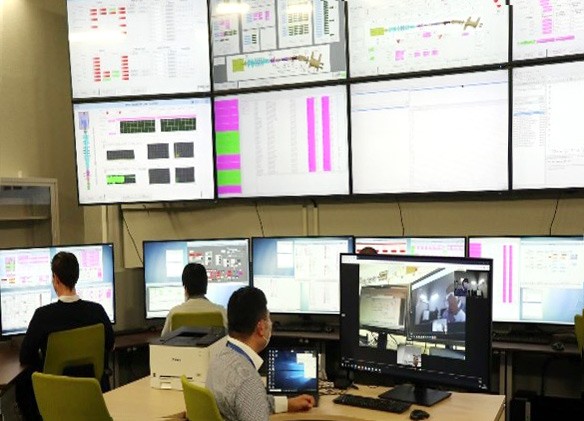Europe and Japan develop new tools to remotely follow up LIPAc

Panoramic picture of LIPAc with some elements indicated, such as the Radio Frequency Quadrupole (RFQ), or the Medium Energy Beam Transport (MEBT) and High Energy Beam Transport (HEBT) lines.
LIPAc, the Linear IFMIF Prototype Accelerator, will allow scientists from Europe and Japan to validate the design of the particle accelerator of the future neutron source facility to test materials for DEMO, the fusion machine after ITER.
LIPAc is located in the Rokkasho Fusion Institute, and for those working there, the outbreak of COVID-19 posed a number of challenges in the regular execution of activities. Many experts returned to Europe and all the missions to Japan to support on-site activities were cancelled. Last April, operations on-site had to be reduced and some systems were stopped in prevision of a potential shutdown of the site. The threat of a general lockdown was real, which would have led to a closure of the site and a total shutdown of LIPAc to protect the machine.
Resuming the activities mid-May the staff had to adapt to a new working style. It was clear they had to make further use of teleworking tools and implement new procedures to coordinate the activities. By the end of summer, with the remote support from the staff based in Europe, they developed around 80 additional procedures to run LIPAc safely.
However, this is not the only synergy. The IFMIF team worked closely with colleagues from IFERC to develop a safe ICT environment so as to offer experts remote access to data and interfaces. All this effort in terms of documentation and ICT tools represents a significant progress in operational management and facilitates the involvement of different experts when needed. The combination of a minimum amount of personnel on-site and remote support is currently the new norm at IFMIF.

For instance, some LIPAc components are being remotely commissioned, such as the High Energy Beam Transport line and the Beam Dump. The validation of the engineering design of the equipment at this commissioning stage (so-called High Duty Cycle Deuteron operation at 5 MeV, 125 mA) is of utmost importance and will have a direct impact on DONES, the DEMO Oriented Neutron Source facility to be hosted in Granada, Spain.
“Due to the impossibility for the EU experts and contractors to travel to Japan for the preparation and execution of the forthcoming B+ phase, we have strengthen the coordination between the EU and Japan teams thanks to the optimization and development of ICT tools and procedures. Now we can be more flexible,” stresses Hervé Dzitko, F4E Project Manager for IFMIF/EVEDA.
IFMIF/EVEDA Project Leader Philippe Cara, in turn, summarises the positive outcomes of adjusting to the new scenario posed by the pandemic: “We have been able to adapt and show an outstanding team spirit on-site, with the unfailing support from Europe. We seized the situation imposed by the COVID-19 to improve our technical and organizational capability. We have already gained in efficiency and in control of the machine, which will be a gain of time when we restart beam operation. The past 8 months have been really challenging, but we are now better prepared for the challenges ahead in 2021.”